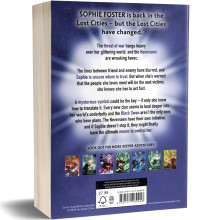About the Book
Introduction and Notes by John S. Whitley, University of Sussex.
Wuthering Heights is a wild, passionate story of the intense and almost demonic love between Catherine Earnshaw and Heathcliff, a foundling adopted by Catherine’s father. After Mr Earnshaw’s death, Heathcliff is bullied and humiliated by Catherine’s brother Hindley and wrongly believing that his love for Catherine is not reciprocated, leaves Wuthering Heights, only to return years later as a wealthy and polished man. He proceeds to exact a terrible revenge for his former miseries.
The action of the story is chaotic and unremittingly violent, but the accomplished handling of a complex structure, the evocative descriptions of the lonely moorland setting and the poetic grandeur of vision combine to make this unique novel a masterpiece of English literature.
About the Author
Emily Brontë
Emily Jane Brontë (1818-1848) is widely considered to be the greatest writer of the three Brontë sisters. She published only the one novel, 'Wuthering Heights' in 1847, an intense story of almost demonic love and revenge, which over the years has come to be placed among the greatest works of English literature.
Emily Brontë wrote only one novel, Wuthering Heights, but it has been supremely successful, reaching far beyond its origins in the Yorkshire moors to become popular in cultures far removed from the novel’s setting. It’s estimated that Wuthering Heights has been translated more than any other Bronte novel, into 61 languages (though some in abridged forms), see http://brusselsbronte.blogspot.co.uk/2016/12/the-translations-wuthering-heights-on.html.
None of this could have been predicted when Emily was born on July 30th, 1818, in Thornton, near Bradford, where her father Patrick was the parson. She was the fifth child, preceded by Maria (1814) and Elizabeth (1815), both to die as children, then Charlotte (1816), and Branwell (1817). Anne’s birth was to follow in 1820, and soon afterwards the family settled in Haworth. The proximity of these births was not unusual for the time; however, their mother Maria succumbed to cancer and died in 1821. Emily was 3 years old. The situation was thus set for the story of the Brontë sisters and their brother Branwell, all of whom were to make their creative mark.
Emily Brontë is often characterised as the stay-at-home, private sister, wedded to the moors and to Haworth Parsonage, but in fact, she spent significant periods away from Haworth. In 1824, she attended Cowan Bridge School for the daughters of poor clergy, alongside Maria, Elizabeth and Charlotte. It was here, in 1825, that Maria and Elizabeth fell ill, and died soon afterwards, probably from tuberculosis, and Charlotte and Emily were brought home. Cowan Bridge is used as the model for Lowood in Jane Eyre.
It was during the subsequent period of education at home that the remaining siblings created their imagined world of Glass Town/Angria, acted out in plays, its chronicles recorded in tiny script on miniature manuscripts and books, largely attributable to Charlotte and Branwell. This created world was to feed later into the world of Gondal, constructed solely by Emily and Anne, and the occasion for Emily’s first poems. See https://www.poetryfoundation.org/poems-and-poets/poets/detail/emily-bronte for a current understanding of Brontë’s poetry. In 1835, at the age of 17, she spent a few months as a pupil at Roe Head School, where Charlotte was training as a teacher, but quickly returned to Haworth, possibly because of homesickness. Charlotte noted of her at this time:
‘Every morning when she woke, the vision of home and the moors rushed on her, and darkened and saddened the day that lay before her’. [Quoted in Winifred Gérin, Emily Brontë, OUP, 1978]</p >
In spite of her attachment to the home, Emily went to teach at Law Hill School, Halifax, either in the Autumn of 1837 or early in 1838, presumably under pressure to earn a living. The evidence is ambiguous as to how long she stayed there, but she was certainly back in Haworth later in 1838. Her productive period as a poet began under the stimulus of Law Hill and continued
on her return to Haworth. Emily now remained at home, undoubtedly writing poetry, while Branwell, Anne and Charlotte attempted paying positions away from home. Her final sojourn away from Haworth was to accompany Charlotte to the Pensionnât Héger in Brussels in February 1842. Our understanding of the effect of this period abroad on Emily has been skewed by our knowing so much more about its effect on Charlotte. Yet this rupture must also have had a profound imaginative effect on Emily, but, in the absence of documentation, what that was is unknowable. Both sisters had to return home suddenly in November 1842 on the news of Aunt Branwell’s (their mother’s sister’s) death. Charlotte was to return to Brussels, but this was to be Emily’s final homecoming to Haworth.
From this point on, Emily undertook many of the household tasks – cooking, cleaning, and baking bread, as well as the companionship of her father. She walked the moors. And during this period she continued her imaginative writing, though in such a secretive manner that only retrospectively did even Charlotte discover the extent of her production, in her poetry notebook, which first prompted the sisters to the idea of publication. Thus in 1845, when all four siblings were at home again at Haworth, Charlotte came upon Emily’s notebook containing 43 poems. Anne also offered some poems, and a joint publication by all three sisters was conceived. In March 1846, the poems were published under the pseudonyms of Acton, Currer and Ellis Bell, subsidised by the sisters’ own funds, under the imprint of Aylott and Jones. This was but a prologue to the works of fiction then offered by the sisters to the same publisher, who did not publish fiction but passed them on to fellow publishers. T. C. Newby accepted Anne’s (Agnes Grey) and Emily’s novels but not Charlotte’s (The Professor). Thus was Emily Bronte’s Wuthering Heights first offered to the outside world.
The trajectory of its actual writing is unknown – we can only speculate that it must have been taking shape certainly in 1845-6 and possibly earlier than that. It was, after much delay, published in two volumes, with Anne Brontë’s Agnes Grey making up the third volume, in December 1847 – three months after Smith and Elder published Charlotte’s sensationally successful Jane Eyre. The precariousness of any of the Brontë novels ever coming into print and before the public reminds us of how narrowly we might have missed knowing these brilliant fictions. Emily herself cannot have foreseen the remarkable reception of Wuthering Heights in succeeding centuries and would have had scant satisfaction from contemporary reviews which concentrated on its shocking and savage elements. Yet surely she must have felt any author’s satisfaction in knowing that her extraordinary work of imagination was not born to blush unseen.
Emily Brontë died on December 19th, 1848, after an illness of only two months which began soon after the death of Branwell (his funeral on October 1st was the last day she went out). The cause of death declared by her doctor was consumption, what we now term tuberculosis. She resisted all medical help during her last illness until her very last hours. Her funeral was conducted by the Revd. Arthur Nicholls, later to become Charlotte’s husband, is buried in Haworth churchyard. Charlotte wrote to her great friend Ellen Nussey, ‘Yes; there is no more Emily in time or on earth now’.
- Langue
- Anglaise
- Dimensions
- 127 mm x 198 mm
- Edition
- Wordsworth Editions
- Collection
- Wordsworth Classics
- Auteur
- Anne Brontë
- Poids
- 181 g
- Nombre de pages
- 248 pages
- Date de Parution
- 05/05/1992
- Série
- Classics






























